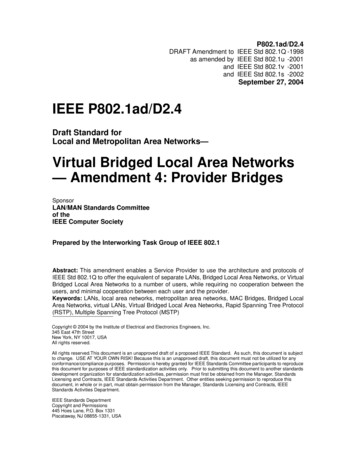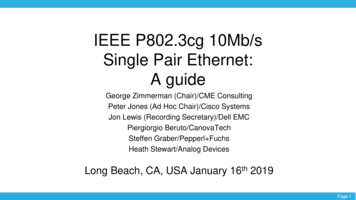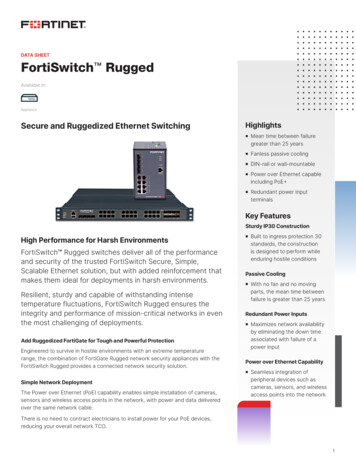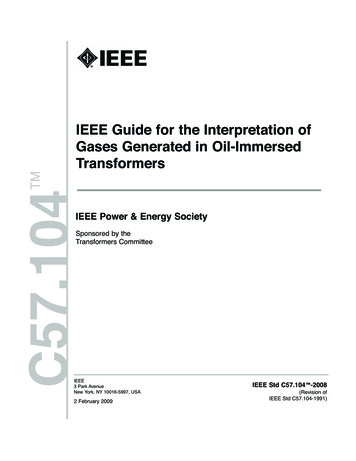
Transcription
P802.1ad/D2.4DRAFT Amendment toas amended byandandIEEE Std 802.1Q -1998IEEE Std 802.1u -2001IEEE Std 802.1v -2001IEEE Std 802.1s -2002September 27, 2004IEEE P802.1ad/D2.4Draft Standard forLocal and Metropolitan Area Networks—Virtual Bridged Local Area Networks— Amendment 4: Provider BridgesSponsorLAN/MAN Standards Committeeof theIEEE Computer SocietyPrepared by the Interworking Task Group of IEEE 802.1Abstract: This amendment enables a Service Provider to use the architecture and protocols ofIEEE Std 802.1Q to offer the equivalent of separate LANs, Bridged Local Area Networks, or VirtualBridged Local Area Networks to a number of users, while requiring no cooperation between theusers, and minimal cooperation between each user and the provider.Keywords: LANs, local area networks, metropolitan area networks, MAC Bridges, Bridged LocalArea Networks, virtual LANs, Virtual Bridged Local Area Networks, Rapid Spanning Tree Protocol(RSTP), Multiple Spanning Tree Protocol (MSTP)Copyright 2004 by the Institute of Electrical and Electronics Engineers, Inc.345 East 47th StreetNew York, NY 10017, USAAll rights reserved.All rights reserved.This document is an unapproved draft of a proposed IEEE Standard. As such, this document is subjectto change. USE AT YOUR OWN RISK! Because this is an unapproved draft, this document must not be utilized for anyconformance/compliance purposes. Permission is hereby granted for IEEE Standards Committee participants to reproducethis document for purposes of IEEE standardization activities only. Prior to submitting this document to another standardsdevelopment organization for standardization activities, permission must first be obtained from the Manager, StandardsLicensing and Contracts, IEEE Standards Activities Department. Other entities seeking permission to reproduce thisdocument, in whole or in part, must obtain permission from the Manager, Standards Licensing and Contracts, IEEEStandards Activities Department.IEEE Standards DepartmentCopyright and Permissions445 Hoes Lane, P.O. Box 1331Piscataway, NJ 08855-1331, USA
IEEE Standards documents are developed within the IEEE Societies and the Standards Coordinating Committees of theIEEE Standards Association (IEEE-SA) Standards Board. The IEEE develops its standards through a consensus development process, approved by the American National Standards Institute, which brings together volunteers representing variedviewpoints and interests to achieve the final product. Volunteers are not necessarily members of the Institute and serve without compensation. While the IEEE administers the process and establishes rules to promote fairness in the consensus development process, the IEEE does not independently evaluate, test, or verify the accuracy of any of the information containedin its standards.Use of an IEEE Standard is wholly voluntary. The IEEE disclaims liability for any personal injury, property or other damage, of any nature whatsoever, whether special, indirect, consequential, or compensatory, directly or indirectly resultingfrom the publication, use of, or reliance upon this, or any other IEEE Standard document.The IEEE does not warrant or represent the accuracy or content of the material contained herein, and expressly disclaimsany express or implied warranty, including any implied warranty of merchantability or fitness for a specific purpose, or thatthe use of the material contained herein is free from patent infringement. IEEE Standards documents are supplied “AS IS.”The existence of an IEEE Standard does not imply that there are no other ways to produce, test, measure, purchase, market,or provide other goods and services related to the scope of the IEEE Standard. Furthermore, the viewpoint expressed at thetime a standard is approved and issued is subject to change brought about through developments in the state of the art andcomments received from users of the standard. Every IEEE Standard is subjected to review at least every five years for revision or reaffirmation. When a document is more than five years old and has not been reaffirmed, it is reasonable to concludethat its contents, although still of some value, do not wholly reflect the present state of the art. Users are cautioned to checkto determine that they have the latest edition of any IEEE Standard.In publishing and making this document available, the IEEE is not suggesting or rendering professional or other services for,or on behalf of, any person or entity. Nor is the IEEE undertaking to perform any duty owed by any other person or entity toanother. Any person utilizing this, and any other IEEE Standards document, should rely upon the advice of a competentprofessional in determining the exercise of reasonable care in any given circumstances.Interpretations: Occasionally questions may arise regarding the meaning of portions of standards as they relate to specificapplications. When the need for interpretations is brought to the attention of IEEE, the Institute will initiate action to prepareappropriate responses. Since IEEE Standards represent a consensus of concerned interests, it is important to ensure that anyinterpretation has also received the concurrence of a balance of interests. For this reason, IEEE and the members of itssocieties and Standards Coordinating Committees are not able to provide an instant response to interpretation requestsexcept in those cases where the matter has previously received formal consideration.Comments for revision of IEEE Standards are welcome from any interested party, regardless of membership affiliation withIEEE. Suggestions for changes in documents should be in the form of a proposed change of text, together with appropriatesupporting comments. Comments on standards and requests for interpretations should be addressed to:Secretary, IEEE-SA Standards Board445 Hoes LaneP.O. Box 13 31Piscataway, NJ 08855-1331USANote: Attention is called to the possibility that implementation of this standard may require use of subject matter covered by patent rights. By publication of this standard, no position is taken with respect to the existence orvalidity of any patent rights in connection therewith. The IEEE shall not be responsible for identifying patentsfor which a license may be required by an IEEE standard or for conducting inquiries into the legal validity orscope of those patents that are brought to its attention.Authorization to photocopy portions of any individual standard for internal or personal use is granted by the Institute ofElectrical and Electronics Engineers, Inc., provided that the appropriate fee is paid to Copyright Clearance Center. Toarrange for payment of licensing fee, please contact Copyright Clearance Center, Customer Service, 222 Rosewood Drive,Danvers, MA 01923 USA; (978) 750-8400. Permission to photocopy portions of any individual standard for educationalclassroom use can also be obtained through the Copyright Clearance Center.bCopyright 2004 IEEE. All rights reserved.This is an unapproved IEEE Standards Draft, subject to change.
Supplement to Virtual Bridged Local Area Networks: Provider BridgesP802.1ad/D2.4September 27, 2004Editors’ Foreword Notes Throughout this document, all notes such as this one, presented between angle braces, are temporarynotes inserted by the Editors for a variety of purposes; these notes and the Editors’ Foreword will all beremoved prior to publication and are not part of the normative text. Comments and participation in 802.1 standards developmentComments on this draft are encouraged. PLEASE NOTE: All issues related to IEEE standardspresentation style, formatting, spelling, etc. are routinely handled between the 802.1 Editor and theIEEE Staff Editors prior to publication, after balloting and the process of achieving agreement on thetechnical content of the standard is complete. Readers are urged to devote their valuable time and energyonly to comments that materially affect either the technical content of the document or the clarity of thattechnical content. Comments should not simply state what is wrong, but also what might be done to fix theproblem. Full participation in the development of this draft requires individual attendance at IEEE 802meetings. Information on 802.1 activities, working papers, and email distribution lists etc. can befound on the 802.1 Website:http://ieee802.org/1/Use of the email distribution list is not presently restricted to 802.1 members, and the workinggroup has had a policy of considering ballot comments from all who are interested and willing tocontribute to the development of the draft. Individuals not attending meetings have helped toidentify sources of misunderstanding and ambiguity in past projects. Non-members are advisedthat the email lists exist primarily to allow the members of the working group to develop standards,and are not a general forum.Comments on this document may be sent to the 802.1 email exploder, to the editors, or to theChairs of the 802.1 Working Group and Interworking Task Group.Mick SeamanChair, 802.1 Interworking Task Group160 Bella Vista AveBelvedereCA 94041USAEmail:mick seaman@ieee.orgTony JeffreeChair, 802.1 Working Group11A Poplar GroveSaleCheshireM33 3AXUK 44 161 973 4278 (Tel) 44 161 973 6534 (Fax)Email: tony@jeffree.co.ukPLEASE NOTE: Comments whose distribution is restricted in any way cannot beconsidered, and may not be acknowledged. A reference to the IEEE’s patent policy will be added to this introductory text. Copyright 2004 IEEE. All rights reserved.This is an unapproved IEEE Standards Draft, subject to change.a
P802.1ad/D2.4September 27, 2004LOCAL AND METROPOLITAN AREA NETWORKS Overview: Draft text and accompanying informationThis document currently comprises:A cover page, identical to the title page.The editors’ introductory notes to each draft, briefly summarizing the progress and focus of eachsuccessive draft.The title page for this amendment including an Abstract and Keywords. This title page will be retainedfor the period that the amendment is published as a separate document.The amendment proper, documented in the usual form for amendments to 802 standards; i.e., as anexplicit set of editing instructions that, if correctly applied to the text of 802.1Q, will create a correcteddocument.An Annex Z comprising the editors’ discussion of issues. This annex will be deleted from thedocument prior to sponsor ballot.Editors’ notes throughout the document, including requests for comment on specific issues andpointing deficiencies in the current draft.IEEE boilerplate text.The records of participants in the development of the standard, the introduction to 802 standards, and theintroduction to this revision of the standard are not included, and will be added at an appropriate time.During the early stages of draft development, 802.1 editors have a responsibility to attempt to craft technicallycoherent drafts from the resolutions of ballot comments and the other discussions that take place in theworking group meetings. Preparation of drafts often exposes inconsistencies in editors instructions orexposes the need to make choices between approaches that were not fully apparent in the meeting. Choicesand requests by the editors’ for contributions on specific issues will be found in the editors’ introductory notesto the current draft, at appropriate points in the draft, and in Annex Z. Significant discussion of more difficulttopics will be found in the last of these.The ballot comments received on each draft, and the editors’ proposed and final disposition of comments, arepart of the audit trail of the development of the standard and are available, along with all the revisions of thedraft on the 802.1 website (for address see above). Editor’s Introduction to the current draft.P802.1ad/D2.4 is work in progress. Not all proposed dispositions from the D2.0 ballot have been included asyet. However the majority of the work required to properly include Drop Precedence has been completed,pending review by the group. Please review the revised Annex G in particular. Though strictly informative, itspells out a rationale for the technical changes that has to be (or be changed to be) more or less acceptable ifwe are to proceed with any degree of ceratinty that we know what we are doing. Other significant text is to befound near the end of Clause 6.Clause 15 and the naming used to identify the functional roles of Ports at or near the edge of the network hasalso been revised significantly, in line with but hopefully an improvement on that tentatively proposed in theballot disposition.The intent is that comments received on the above will be taken into account, if possible, prior to issuing aballot on a revised draft (to include other proposed dispositions on the D2.0 ballot) shortly after the October2004 interim, closing in time to address comments in the November plenary meeting. Editor’s Introduction to prior drafts (excerpts of continuing relevance).P802.1ad/D2.0 has been/will be distributed for task group ballot as agreed at the November 2003 meeting. Itremains work in progress, and known not to be completely consistent. The purpose of the task group ballot isto checkpoint the development so far and to provide a structured way of gathering further input from allparticipants. Those responding to the task group ballot will assist the process of further development byfocusing on the major concepts, issues, and terminology. Comments on detailed wording, unless questionsbCopyright 2004 IEEE. All rights reserved.This is an unapproved IEEE Standards Draft, subject to change.
Supplement to Virtual Bridged Local Area Networks: Provider BridgesP802.1ad/D2.4September 27, 2004about intent and opinions as to direction, are largely a waste of time. Comments to the effect that the draft isincomplete may be treated as “Abstain due to lack of expertise”.The conformance clause has been largely reorganized as a result of the November 2003 and priordiscussions, and clause 15 has also been updated to correspond to our latest thinking. To minimizeuncertainty as to what is new, and what is being superseded (there never being enough time for the editor tofinely polish each draft during task group balloting stage). The draft is probably best read for the first time inthe following order—Clause 5.9 (Provider Bridge Conformance)—Clause 5 in its entirety (Conformance)—Clause 15 (Support of the MAC Service by Provider Bridged Networks)—Clause 8 (Principles of Bridge operation)—The whole document in serial clause orderThe editor has not had the time, or the inspiration, to resolve the difficulties around drop precedence (implicitor explicit) to his satisfaction, so nothing on this subject has yet been incorporated. Further comemnts arerequested.P802.1ad/D1.4, is work in progress. It does not complete the resolution of P802.1ad/D1 ballot comments.However, given the significant task group discussion and the many changes that have already been made toprogress the resolution of those comments, it is time that we held another task group ballot. That ballot shouldtest the extent to which prior comments have been successfully addressed, establish which comments arestill outstanding, and allow the task group to take stock of the progress to date.P802.1ad/D1.4 has been distributed prior to the November meeting to facilitate discussion at that meeting ofwhich issues and anomalies should be fixed prior to task group ballot, largely to save everyone’s time on thatballot. The editor does not believe that the current draft is complete, though it should be far more internallyconsistent than prior drafts, nor that we should strive for completion prior to taking stock by way of a taskgroup ballot. We are, after all, at task group ballot level, not working group ballot level on this draft. Thesuggested objective is to keep the remaining changes prior to ballot few enough (or on a best efforts basis) tocommence the ballot by December 1st, and allow at least a week for collation of comments prior to thefollowing interim (yet to be announced).Clause 15 has been added, and builds further on our architectural decision (see note to P802.1ad/D3 below)as part of dealing with comments. It is clearly possible to expand significantly on the material in this clause,focusing on the transport characteristics of the customer interface. A note refers to the Bibliography for otheraspects of the interface, and this is an appropriate place to reference MEF and ITU work in this area. Howmuch we want to further describe the customer interface is a question for discussion, as is overlap withClause 16.P802.1ad/D1.3 is work in progress. It continues, but does not complete the task of providing text that mayserve to assist resolution of P802.1ad/D1 ballot comments.Clause 8 has been significantly revised to take into account our decision on the architecture (per SteveHaddock’s presentation and the working group resolution). The MAC dependent aspects of bridgefunctionality have been excised from clause 8 and placed in clause 6 as required to make the architecturework correctly. In doing the work it was apparent that changes needed to be applied after essentialmaintenance to the clause, so it has been presented (almost) in its entirety. The editor has also madesignificant efforts to replace out of date material with applicable text from the recently passed sponsor ballotdraft of P802.1D.Clause 9 has also been significantly revised as required to provide a secure base for this amendment.A number of issues have been discovered with Clauses 8 and 9, both with respect to maintenance wheredefects in the standard 802.1Q text have been discovered, and with respect to technical choices onP802.1ad. The editor will raise these in the upcoming interim meeting.P802.1ad/D1.1, is work in progress. It includes some, but by no means all of the proposed resolutions to theballot on P802.1ad/D1. The most interesting new material is to be found in Clause 6.Copyright 2004 IEEE. All rights reserved.This is an unapproved IEEE Standards Draft, subject to change.c
P802.1ad/D2.4September 27, 2004LOCAL AND METROPOLITAN AREA NETWORKSP802.1ad/D1 was prepared by the P802.1ad editor, Mick Seaman, for task group ballot, comments receivedwill be considered at the June 2003 interim meeting of IEEE 802.1.Clause 16 of this draft is a detailed description of the ‘Principles of Provider Network Operation’. While this isbased on discussion at the January and March 2003 meetings, this text has not been reviewed before andballot comments are particularly requested. Other clauses have not changed significantly since the first draft,P802.1D0, and may well be found to be out of alignment with Clause 16. The intention is to resolve clause 16issues and options, and then incorporate the necessary supporting changes in the other clauses. dCopyright 2004 IEEE. All rights reserved.This is an unapproved IEEE Standards Draft, subject to change.
P802.1ad/D2.4DRAFT Amendment toas amended byandandIEEE Std 802.1Q -1998IEEE Std 802.1u -2001IEEE Std 802.1v -2001IEEE Std 802.1s -2002September 27, 2004IEEE P802.1ad/D2.4Draft Standard forLocal and Metropolitan Area Networks—Virtual Bridged Local Area Networks— Amendment 4: Provider BridgesSponsorLAN/MAN Standards Committeeof theIEEE Computer SocietyPrepared by the Interworking Task Group of IEEE 802.1Abstract: This amendment enables a Service Provider to use the architecture and protocols ofIEEE Std 802.1Q to offer the equivalent of separate LANs, Bridged Local Area Networks, or VirtualBridged Local Area Networks to a number of users, while requiring no cooperation between theusers, and minimal cooperation between each user and the provider.Keywords: LANs, local area networks, metropolitan area networks, MAC Bridges, Bridged LocalArea Networks, virtual LANs, Virtual Bridged Local Area Networks, Rapid Spanning Tree Protocol(RSTP), Multiple Spanning Tree Protocol (MSTP)Copyright 2004 by the Institute of Electrical and Electronics Engineers, Inc.345 East 47th StreetNew York, NY 10017, USAAll rights reserved.All rights reserved.This document is an unapproved draft of a proposed IEEE Standard. As such, this document is subjectto change. USE AT YOUR OWN RISK! Because this is an unapproved draft, this document must not be utilized for anyconformance/compliance purposes. Permission is hereby granted for IEEE Standards Committee participants to reproducethis document for purposes of IEEE standardization activities only. Prior to submitting this document to another standardsdevelopment organization for standardization activities, permission must first be obtained from the Manager, StandardsLicensing and Contracts, IEEE Standards Activities Department. Other entities seeking permission to reproduce thisdocument, in whole or in part, must obtain permission from the Manager, Standards Licensing and Contracts, IEEEStandards Activities Department.IEEE Standards DepartmentCopyright and Permissions445 Hoes Lane, P.O. Box 1331Piscataway, NJ 08855-1331, USA
P802.1ad/D2.4September 27, 2004LOCAL AND METROPOLITAN AREA NETWORKSIEEE Standards documents are developed within the IEEE Societies and the Standards Coordinating Committees of theIEEE Standards Association (IEEE-SA) Standards Board. The IEEE develops its standards through a consensus development process, approved by the American National Standards Institute, which brings together volunteers representing variedviewpoints and interests to achieve the final product. Volunteers are not necessarily members of the Institute and serve without compensation. While the IEEE administers the process and establishes rules to promote fairness in the consensus development process, the IEEE does not independently evaluate, test, or verify the accuracy of any of the information containedin its standards.Use of an IEEE Standard is wholly voluntary. The IEEE disclaims liability for any personal injury, property or other damage, of any nature whatsoever, whether special, indirect, consequential, or compensatory, directly or indirectly resultingfrom the publication, use of, or reliance upon this, or any other IEEE Standard document.The IEEE does not warrant or represent the accuracy or content of the material contained herein, and expressly disclaimsany express or implied warranty, including any implied warranty of merchantability or fitness for a specific purpose, or thatthe use of the material contained herein is free from patent infringement. IEEE Standards documents are supplied “AS IS.”The existence of an IEEE Standard does not imply that there are no other ways to produce, test, measure, purchase, market,or provide other goods and services related to the scope of the IEEE Standard. Furthermore, the viewpoint expressed at thetime a standard is approved and issued is subject to change brought about through developments in the state of the art andcomments received from users of the standard. Every IEEE Standard is subjected to review at least every five years for revision or reaffirmation. When a document is more than five years old and has not been reaffirmed, it is reasonable to concludethat its contents, although still of some value, do not wholly reflect the present state of the art. Users are cautioned to checkto determine that they have the latest edition of any IEEE Standard.In publishing and making this document available, the IEEE is not suggesting or rendering professional or other services for,or on behalf of, any person or entity. Nor is the IEEE undertaking to perform any duty owed by any other person or entity toanother. Any person utilizing this, and any other IEEE Standards document, should rely upon the advice of a competentprofessional in determining the exercise of reasonable care in any given circumstances.Interpretations: Occasionally questions may arise regarding the meaning of portions of standards as they relate to specificapplications. When the need for interpretations is brought to the attention of IEEE, the Institute will initiate action to prepareappropriate responses. Since IEEE Standards represent a consensus of concerned interests, it is important to ensure that anyinterpretation has also received the concurrence of a balance of interests. For this reason, IEEE and the members of itssocieties and Standards Coordinating Committees are not able to provide an instant response to interpretation requestsexcept in those cases where the matter has previously received formal consideration.Comments for revision of IEEE Standards are welcome from any interested party, regardless of membership affiliation withIEEE. Suggestions for changes in documents should be in the form of a proposed change of text, together with appropriatesupporting comments. Comments on standards and requests for interpretations should be addressed to:Secretary, IEEE-SA Standards Board445 Hoes LaneP.O. Box 1331Piscataway, NJ 08855-1331USANote: Attention is called to the possibility that implementation of this standard may require use of subject matter covered by patent rights. By publication of this standard, no position is taken with respect to the existence orvalidity of any patent rights in connection therewith. The IEEE shall not be responsible for identifying patentsfor which a license may be required by an IEEE standard or for conducting inquiries into the legal validity orscope of those patents that are brought to its attention.Authorization to photocopy portions of any individual standard for internal or personal use is granted by the Institute ofElectrical and Electronics Engineers, Inc., provided that the appropriate fee is paid to Copyright Clearance Center. Toarrange for payment of licensing fee, please contact Copyright Clearance Center, Customer Service, 222 Rosewood Drive,Danvers, MA 01923 USA; (978) 750-8400. Permission to photocopy portions of any individual standard for educationalclassroom use can also be obtained through the Copyright Clearance Center.iiCopyright 2004 IEEE. All rights reserved.This is an unapproved IEEE Standards Draft, subject to change.
Supplement to Virtual Bridged Local Area Networks: Provider BridgesP802.1ad/D2.4September 27, 2004ContentsEditors’ Foreword .a1. Overview. 11.1Scope. 22. References. 13. Definitions . 24. Abbreviations. 75. Conformance. 85.15.25.35.45.55.65.75.85.95.10Terminology. 8Conformant components and equipment . 8Protocol Implementation Conformance Statement (PICS). 9VLAN-aware Bridge Requirements Static conformance requirements . 9VLAN-aware Bridge Options . 10Customer-VLAN aware Bridge Conformance . 11Service-VLAN aware Bridge Conformance. 12VLAN Bridge Conformance. 13Provider Bridge Conformance . 13MAC-specific bridging methods . 146. Support of the MAC Service in VLANs. 166.16.26.36.46.56.66.76.86.96.10Support of the MAC service . 16Preservation of the MAC service. 16Quality of service maintenance. 17Internal Sublayer Service. 18Support of the Internal Sublayer Service by specific MAC procedures. 20Enhanced Internal Sublayer Service . 22Support of the EISS in VLAN-aware Bridges. 23Support of the ISS for attachment to a Provider Bridged Network . 27Support of the ISS within a system. 28Support of the ISS by additional technologies. 287. Principles of network operation .
P802.1ad/D2.4 LOCAL AND METROPOLITAN AREA NETWORKS Septe










